Introduction
Japan’s rich cultural tapestry comes alive through its vibrant festivals, known as “matsuri,” which offer travelers an authentic glimpse into the country’s traditions, spirituality, and community spirit. Planning your visit around these festivals in Japan by month can transform an ordinary trip into an extraordinary cultural immersion. From snow-covered winter celebrations to summer fireworks illuminating the night sky, Japan’s festival calendar presents year-round opportunities to experience the country’s living heritage.
Japan is a world of beauty, where the past and present are always present in a world of endless wonder.
Ian Buruma

For travelers seeking to align their itineraries with these captivating events, understanding the timing and significance of various matsuri is essential. Each month brings unique celebrations tied to seasonal changes, historical commemorations, or religious observances, creating a diverse festival landscape across Japan’s regions.
Before embarking on your festival-hopping adventure, ensure you have reliable connectivity to navigate between venues, translate festival information, and share your experiences. Gohub’s international eSIM solutions provide seamless internet access throughout Japan, allowing you to focus on the festivities without worrying about connectivity issues or expensive roaming charges.
If you’re planning your trip around a festival, don’t miss what to do in Tokyo between celebrations.
Winter Festivals in Japan: Celebrating Through the Cold
January Festivals: New Year Celebrations and Coming of Age
January in Japan marks not only the beginning of a new year but also hosts some of the country’s most culturally significant celebrations. These winter festivals in Japan showcase how communities come together despite the cold weather.
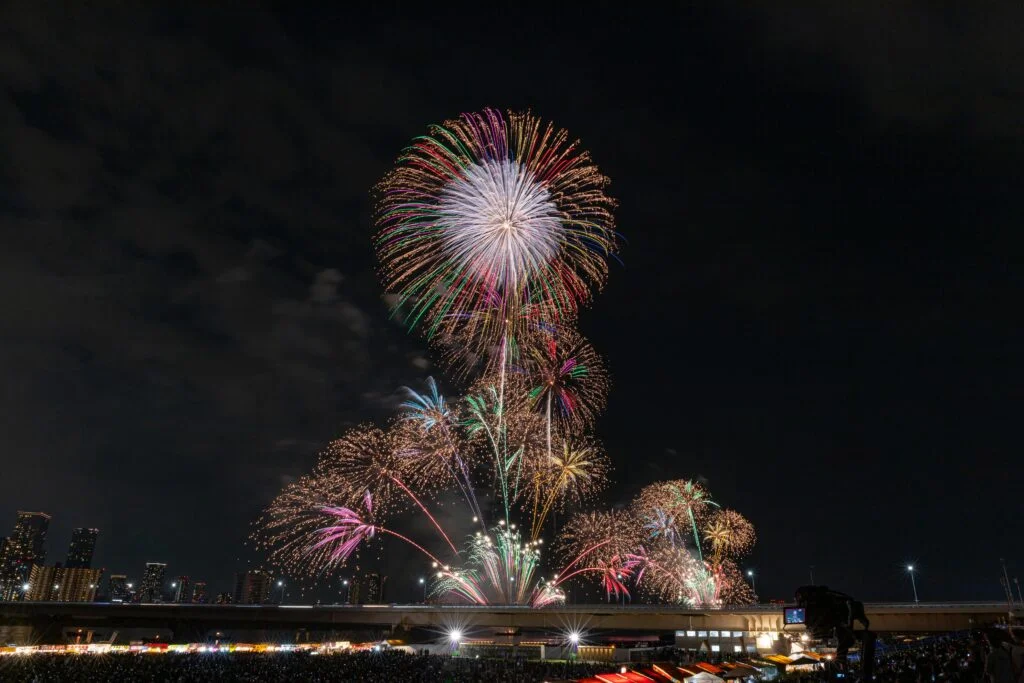
O-Shogatsu: Traditional New Year Festivities
The first three days of January (January 1-3) constitute O-Shogatsu, Japan’s most important holiday period. While not a single festival, this nationwide celebration involves several traditional customs:
- Hatsumode: The first shrine or temple visit of the year, where people pray for good fortune
- Osechi Ryori: Special New Year’s cuisine with symbolic meanings served in elegant stacked boxes
- Otoshidama: Gift-giving tradition where children receive money in decorative envelopes

Image: Hatsumode with traditional decorations
Seijin no Hi: Coming of Age Day Ceremonies
Held on the second Monday of January (January 13, 2025), Seijin no Hi celebrates young adults who have turned or will turn 20 during the current academic year. This national holiday features:
- Formal ceremonies at local government offices
- Young women wearing elaborate furisode (long-sleeved) kimonos
- Young men in traditional hakama or Western-style suits
- Group photos and family celebrations
This traditional Japanese festival offers photographers stunning opportunities to capture beautifully dressed young adults marking their transition to adulthood.
February Matsuri: Snow Spectacles and Bean-Throwing Rituals
February brings some of Japan’s most visually spectacular winter festivals, particularly in the northern regions where snow and ice become artistic mediums.
Sapporo Snow Festival: Hokkaido’s Winter Wonderland
The internationally renowned Sapporo Snow Festival (February 4-11, 2025) transforms Hokkaido’s capital into a magical snow kingdom featuring:
- Massive snow and ice sculptures, some reaching several stories high
- Illuminated displays creating enchanting nighttime scenes
- International snow sculpture competitions
- Food stalls serving regional specialties to warm visitors
This festival attracts millions of visitors annually, so booking accommodation well in advance is essential for travelers planning to attend this popular winter matsuri in Japan.
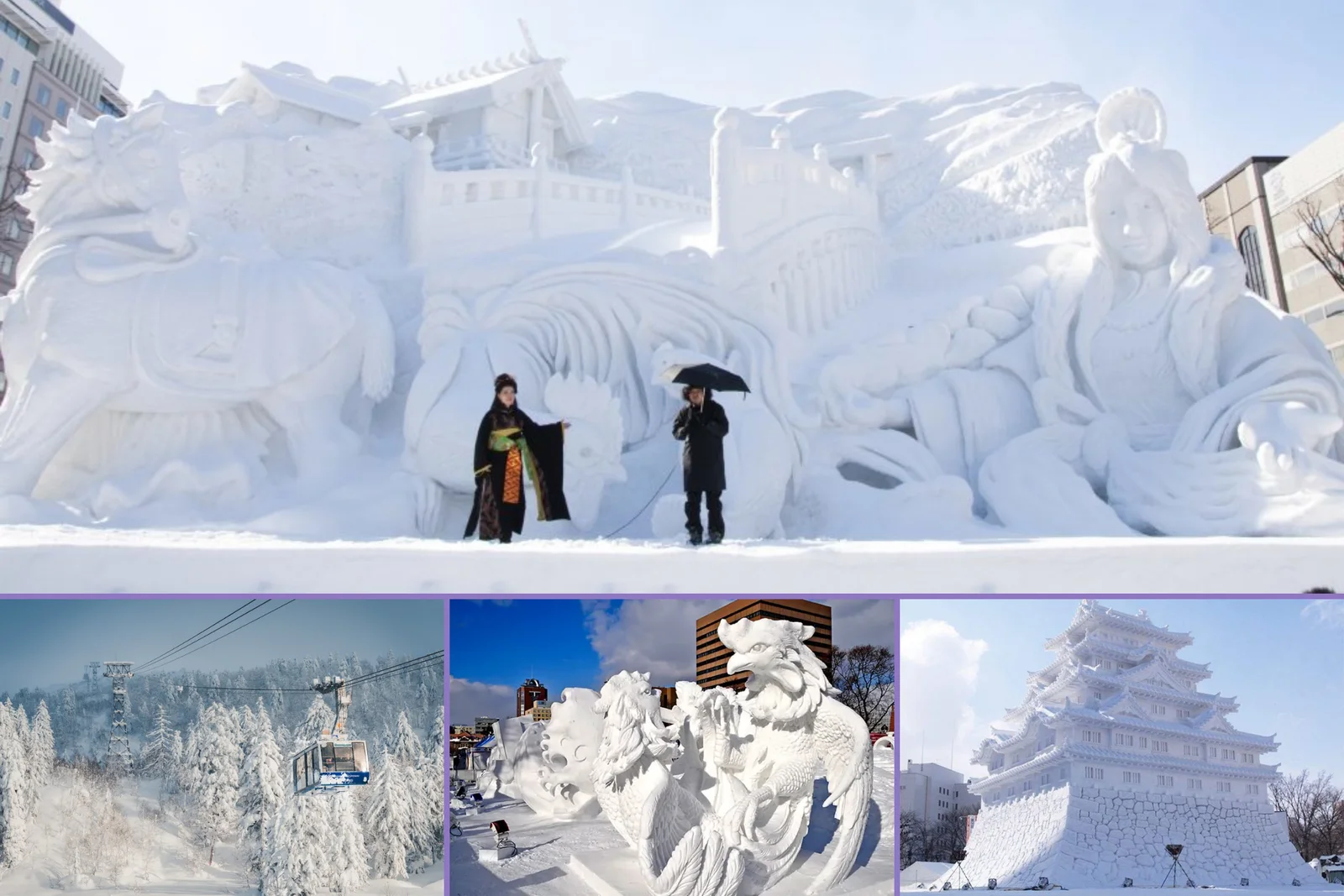
Image: Sapporo Snow Festival
Setsubun: Driving Away Evil Spirits
Celebrated on February 3rd, Setsubun marks the beginning of spring according to the lunar calendar. This nationwide traditional Japanese festival features:
- Mamemaki: The ritual of throwing roasted soybeans while chanting “Oni wa soto! Fuku wa uchi!” (Demons out! Good fortune in!)
- Family members wearing demon masks for children to throw beans at
- Special ehomaki sushi rolls eaten while facing the year’s lucky direction
Major temples like Sensoji in Tokyo and Yoshida Shrine in Kyoto host particularly lively Setsubun celebrations with celebrity bean-throwers and large crowds.
Spring Awakening: March to May Festivals
March Festivals in Japan: Dolls and Early Blossoms
As winter begins to release its grip, March brings celebrations that honor traditions and welcome the changing season.
Hina Matsuri: Girls’ Day Festival
On March 3rd, families with daughters celebrate Hina Matsuri by displaying ornate doll sets representing the imperial court. This charming spring festival in Japan includes:
- Elaborate multi-tiered displays of traditional dolls
- Special foods like chirashi-zushi (scattered sushi) and hina-arare (sweet rice crackers)
- Peach blossom decorations symbolizing feminine qualities
The town of Katsuura in Chiba Prefecture hosts a spectacular version with 30,000 dolls displayed on hillside steps, creating a must-see attraction for March visitors.
Early Hanami: The Beginning of Cherry Blossom Season
Late March marks the start of cherry blossom season in southern regions like Kyushu and parts of Shikoku. While not a structured festival, hanami (flower viewing) is one of Japan’s most beloved seasonal traditions:
- Parks and riverbanks fill with people enjoying picnics under blooming trees
- Temporary food stalls appear in popular viewing spots
- Evening illuminations (yozakura) create magical nighttime viewing opportunities
For travelers planning their trip around cherry blossoms, monitoring the sakura forecast is essential, as bloom times vary by location and year.
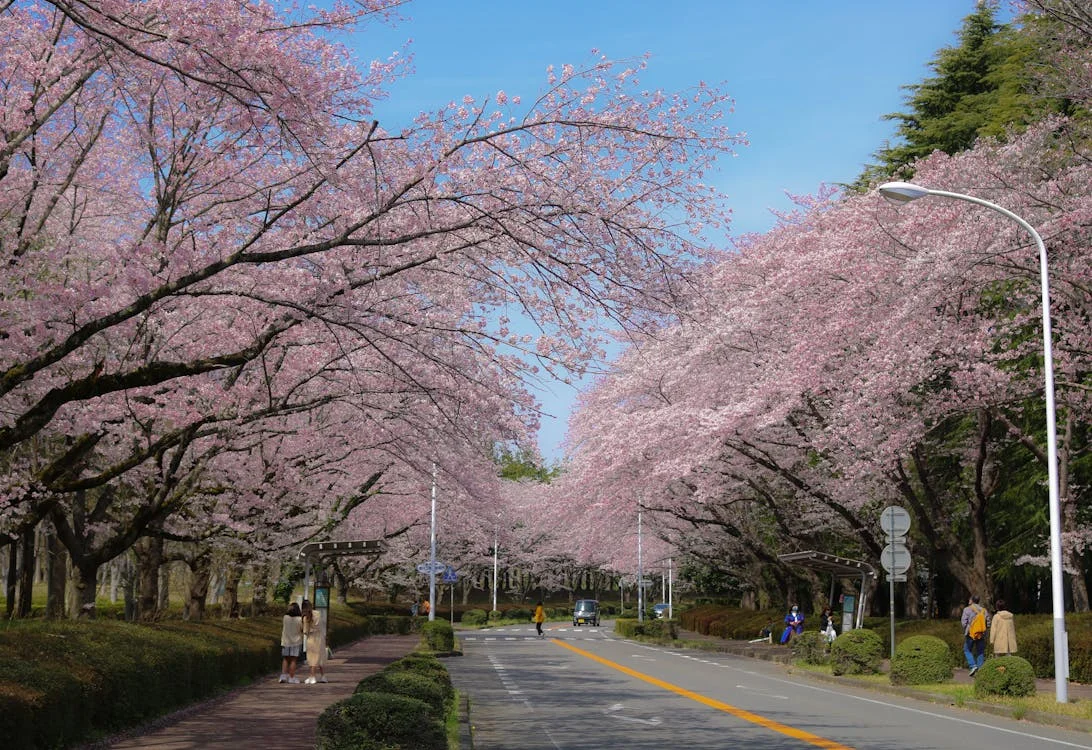
Image: Blooming cherry trees
April Matsuri: Peak Bloom Celebrations and Historic Parades
April represents the heart of spring in Japan, with festivals that celebrate both natural beauty and historical traditions.
Peak Hanami Season: Cherry Blossom Festivals Nationwide
Early to mid-April typically sees cherry blossoms reach full bloom in Tokyo, Kyoto, and other central regions. Notable cherry blossom festivals include:
- Hirosaki Cherry Blossom Festival at Hirosaki Castle
- Chidorigafuchi Boating during Tokyo’s blossom season
- Maruyama Park festivities in Kyoto
These spring festivals in Japan combine natural beauty with cultural celebrations, creating unforgettable experiences for visitors.
Takayama Spring Festival: Historic Float Processions
Held on April 14-15 in Gifu Prefecture, the Takayama Spring Festival is considered one of Japan’s most beautiful traditional festivals. Highlights include:
- Ornate festival floats (yatai) with intricate carvings and mechanical puppets
- Processions through the historic old town
- Nighttime displays with hundreds of lanterns illuminating the floats
- Traditional music and performances
This festival offers a perfect combination of cultural heritage and spring scenery, making it a highlight for April travelers.
May Festivals: Children’s Celebrations and Golden Week
May brings warmer weather and several significant festivals, many coinciding with Golden Week, Japan’s busiest holiday period.
Kodomo no Hi: Children’s Day Celebrations
May 5th marks Kodomo no Hi (Children’s Day), a national holiday celebrating children’s happiness and health. Traditional customs include:
- Colorful carp streamers (koinobori) flying outside homes
- Displays of samurai helmets and armor
- Special foods like kashiwa-mochi (rice cakes wrapped in oak leaves)
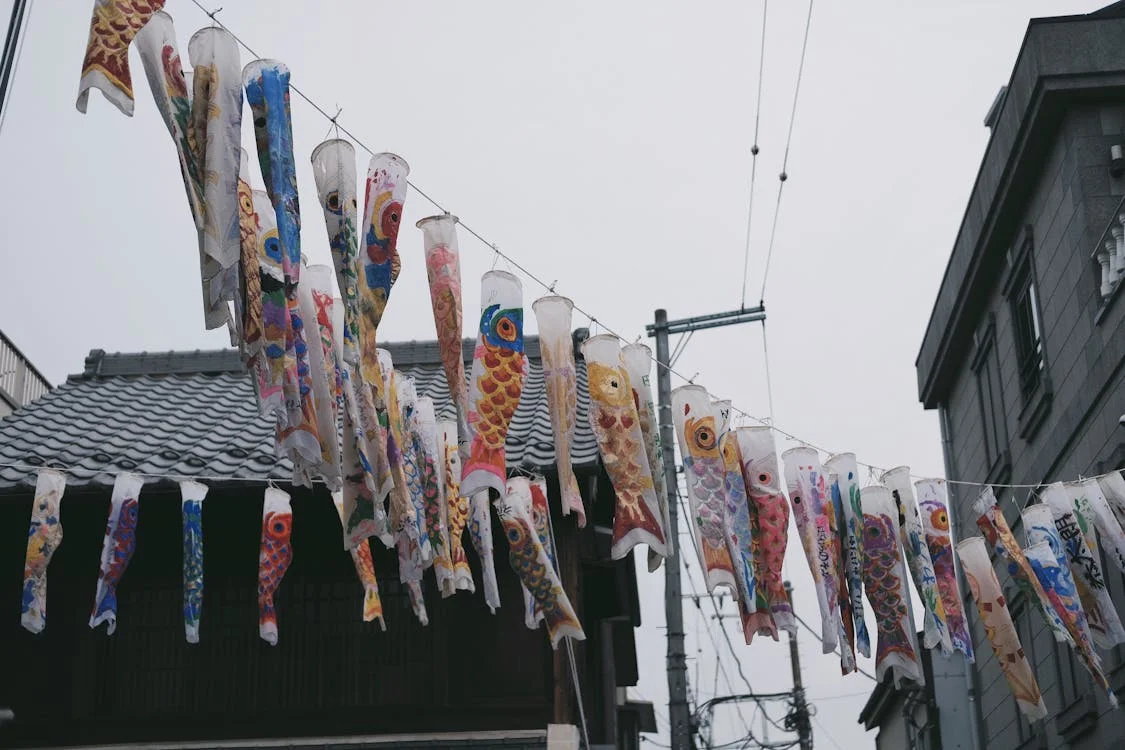
Image: Colorful koinobori carp streamers flying for Children’s Day
Sanja Matsuri: Tokyo’s Energetic Shrine Festival
Usually held on the third weekend of May (May 16-18, 2025), Sanja Matsuri is one of Tokyo’s largest and most exciting traditional Japanese festivals. Centered around Asakusa’s Sensoji Temple, this festival features:
- Over 100 mikoshi (portable shrines) carried through the streets
- Thousands of participants dressed in traditional happi coats
- Taiko drumming, traditional music, and dance performances
- Food stalls and carnival atmosphere throughout Asakusa
The energy and excitement of Sanja Matsuri make it a highlight for May visitors to Tokyo, though prepare for large crowds during this popular spring festival in Japan.
Summer Heat and Festivities: June to August
June Festivals: Quieter Celebrations During Rainy Season
June coincides with Japan’s rainy season (tsuyu), resulting in fewer major festivals. However, some unique celebrations still take place during this quieter month.
Sanno Matsuri: Tokyo’s Imperial Festival
In even-numbered years, the Sanno Matsuri (June 7-17, 2024) is one of Tokyo’s three major festivals. Centered around Hie Shrine near the Imperial Palace, this traditional Japanese festival includes:
- A grand procession through central Tokyo (held only every other year)
- Shinto rituals and performances
- Historical connections to Japan’s shogunate period
In 2025, the festival will be held in a smaller scale without the main procession, making it a more intimate experience.
Yosakoi Soran Festival: Hokkaido’s Dynamic Dance Festival
Held in early June in Sapporo, the Yosakoi Soran Festival features energetic dance performances combining traditional and modern elements:
- Teams of dancers performing throughout the city
- Colorful costumes and naruko hand clappers
- Contemporary music fused with the traditional Soran fisherman’s song
This summer festival in Japan showcases how traditional cultural elements continue to evolve in modern expressions.
July Festivals: The Height of Summer Celebrations
July marks the beginning of Japan’s most active festival season, with major events throughout the country celebrating summer with energy and spectacle.
Gion Matsuri: Kyoto’s Month-Long Festival Extravaganza
Kyoto’s famous Gion Matsuri spans the entire month of July, with main events centered around the Yamaboko Junko parades on July 17 and 24. This ancient festival includes:
- Massive decorated floats weighing up to 12 tons pulled through Kyoto’s streets
- Evening yoiyama street parties on the three nights before each parade
- Display of family heirlooms in machiya townhouses
- Traditional music and performances throughout the month
As one of Japan’s most famous traditional festivals, Gion Matsuri accommodations should be booked months in advance.
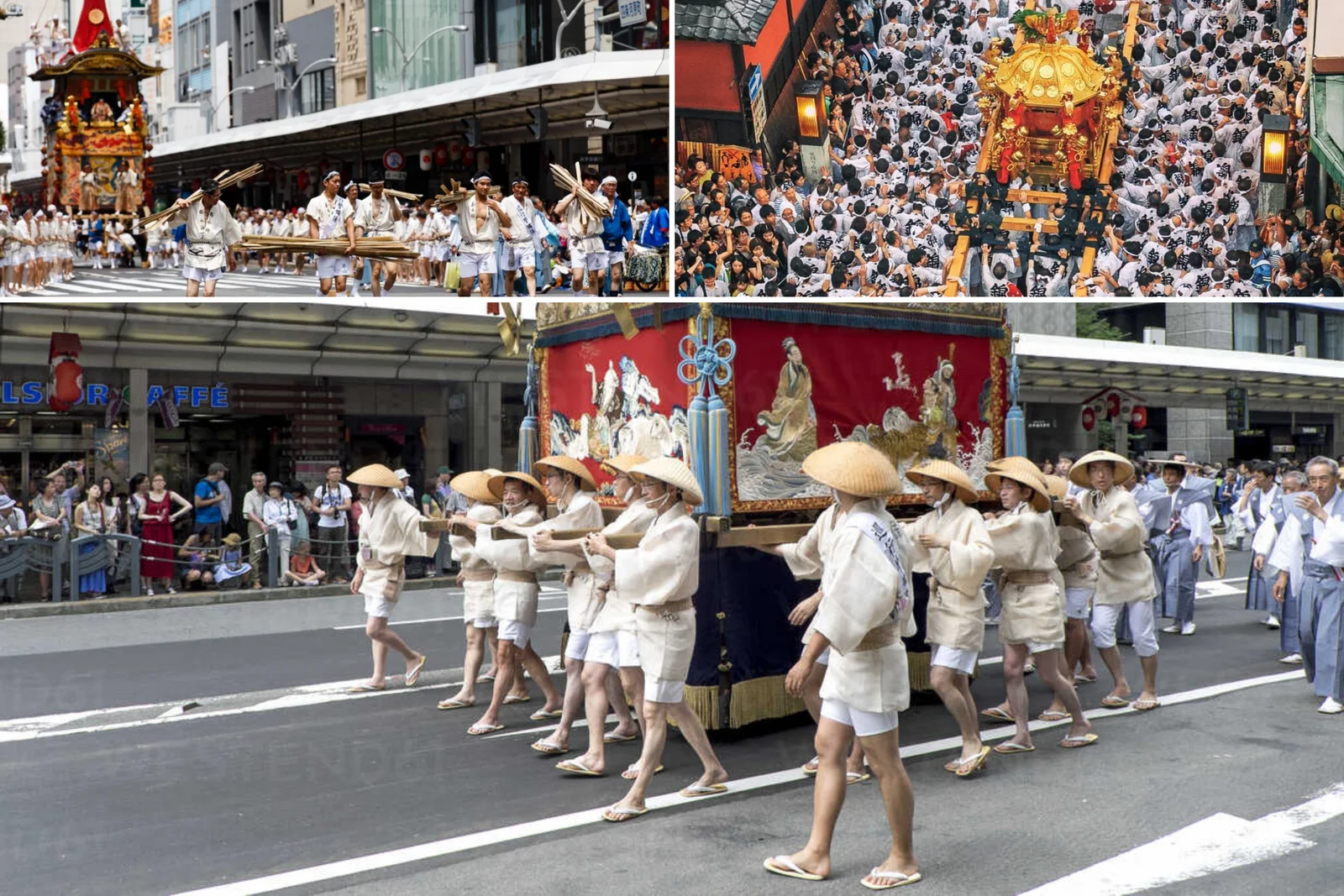
Image: Kyoto’s Gion Matsuri parade
Tenjin Matsuri: Osaka’s Fire and Water Spectacle
Held on July 24-25, Osaka’s Tenjin Matsuri is considered one of Japan’s top three festivals. This dynamic summer matsuri features:
- A river procession with dozens of decorated boats
- Portable shrines carried through the streets
- Spectacular fireworks over the water
- Fire rituals creating a dramatic atmosphere
The combination of fire, water, and festive energy makes Tenjin Matsuri a highlight of July’s festival calendar.
Travel Tip: July festivals often coincide with extreme heat and humidity in Japan. Stay hydrated and use Gohub’s eSIM to check weather forecasts and find air-conditioned rest areas between festival activities.
August Festivals: Obon and Spectacular Fireworks
August brings some of Japan’s most culturally significant and visually stunning festivals, many connected to the Obon period when ancestors’ spirits are believed to return.
Obon Festivals: Honoring Ancestors Nationwide
The Obon period (usually August 13-15) is observed throughout Japan with various local traditions:
- Bon Odori dances performed in circles around a central tower
- Lanterns floated on rivers (Toro Nagashi) to guide spirits
- Grave visits and offerings to ancestors
- Regional variations in customs and timing
Participating in local Bon Odori dances offers travelers a chance to join in community celebrations rather than just observe.
Awa Odori: Tokushima’s Dance Festival
Held August 12-15 in Tokushima on Shikoku Island, Awa Odori is one of Japan’s largest dance festivals with over 400 years of history. Highlights include:
- Thousands of dancers moving through the streets in choreographed groups
- The distinctive call: “Odoru aho ni miru aho, onaji aho nara odoranya son son!” (The dancers are fools, the watchers are fools, if both are fools, you might as well dance!)
- Traditional costumes and amigasa straw hats
- Opportunities for visitors to join special dance sessions
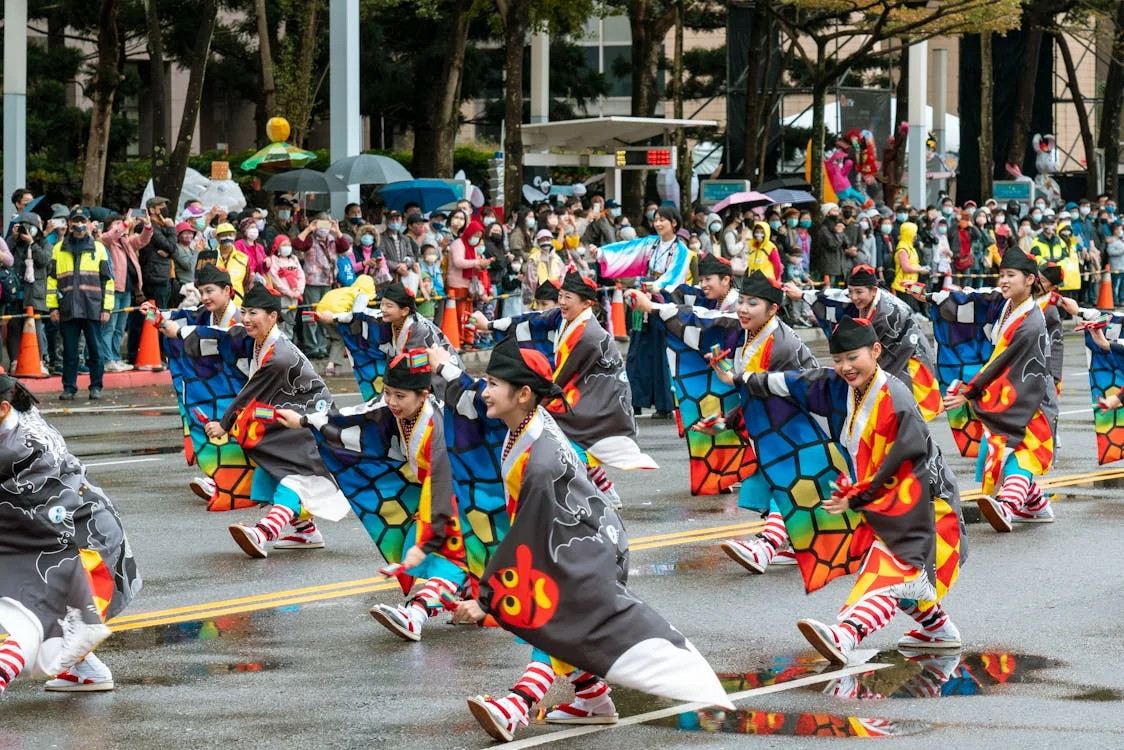
Image: Dancers in traditional costumes performing at Awa Odori Festival
Into creative scenes? After Japan’s traditional beauty, Berlin’s street art is a wild contrast.
Nebuta Matsuri: Aomori’s Illuminated Float Festival
From August 2-7, Aomori City hosts the spectacular Nebuta Matsuri featuring enormous illuminated floats depicting warriors, gods, and creatures from Japanese mythology. This summer festival in Japan includes:
- Massive paper floats illuminated from within
- Teams of dancers (haneto) jumping and chanting alongside the floats
- Opportunities for visitors to participate as dancers with rental costumes
- A final float parade on boats in Aomori Bay
The visual impact of Nebuta Matsuri makes it one of Japan’s most photogenic festivals and a highlight of the August festival calendar.
Autumn into Winter: September to December Festivals
September Festivals: Harvest Celebrations and Moon Viewing
As summer heat gives way to autumn crispness, September brings festivals celebrating harvests and the changing season.
Tsukimi: Moon Viewing Celebrations
Mid-September (September 17, 2025) marks the traditional harvest moon viewing festival called Tsukimi or Otsukimi. This quiet, elegant autumn festival in Japan includes:
- Displays of pampas grass and seasonal foods like tsukimi-dango (round rice dumplings)
- Special moon-viewing locations in gardens and temples
- Cultural activities like poetry writing and music performances
Tokyo’s Rikugien Garden and Kyoto’s Daikaku-ji Temple offer particularly beautiful Tsukimi settings with special evening openings.
Kishiwada Danjiri Matsuri: Osaka’s Thrilling Cart Race
Held in mid-September (September 13-14, 2025) in Osaka Prefecture, this high-energy festival features teams racing massive wooden festival carts (danjiri) through narrow streets. This traditional Japanese festival includes:
- Spectacular displays of strength and coordination
- Dangerous sharp turns executed at high speed
- Team members performing acrobatics atop the moving carts
- Centuries-old traditions dating back to 1703
The excitement and danger of Kishiwada Danjiri Matsuri make it a thrilling spectacle, though viewers should maintain a safe distance.
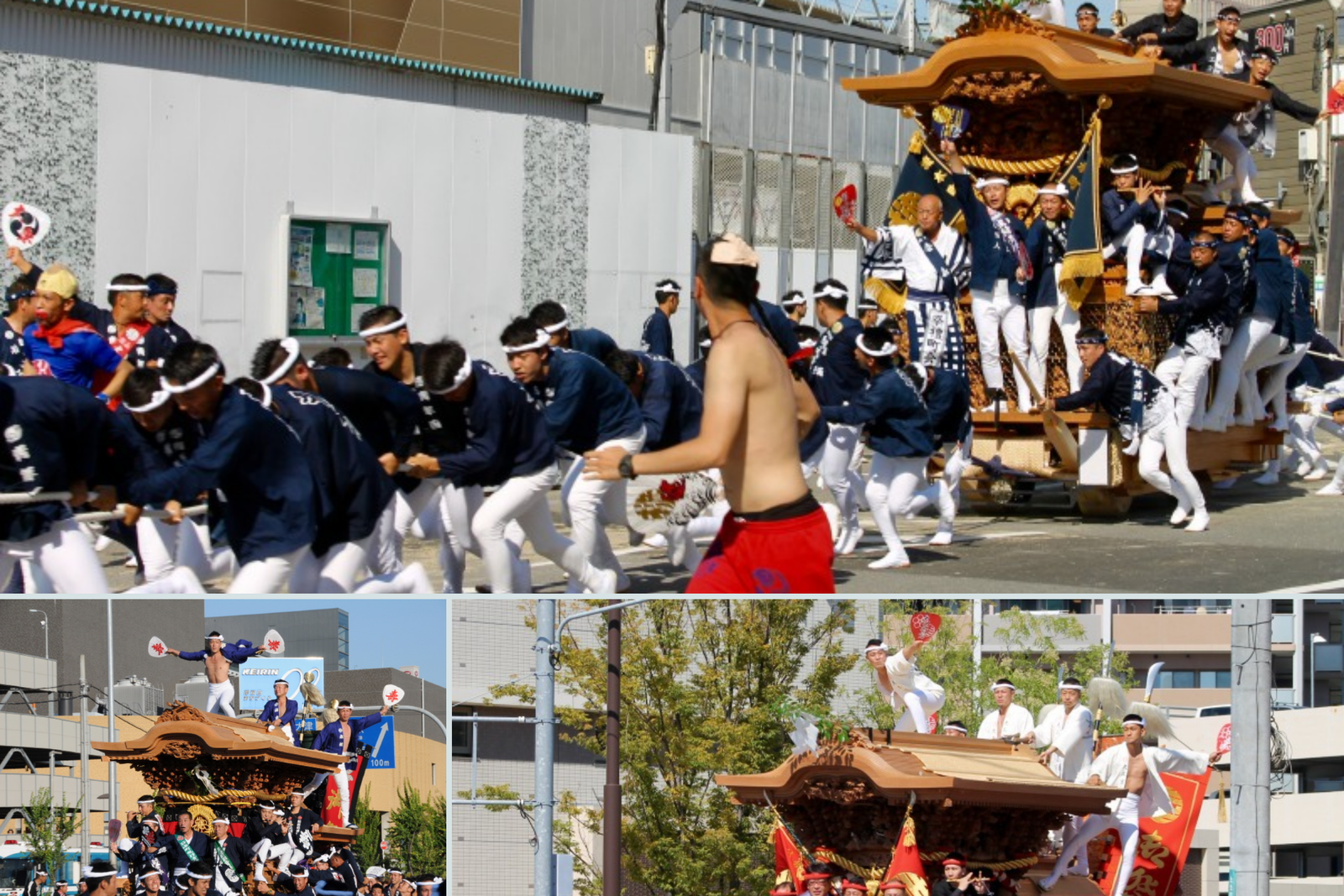
Image: Kishiwada Danjiri Matsuri
October Festivals: Historical Parades and Autumn Colors
October brings comfortable temperatures and the beginning of autumn foliage, creating a beautiful backdrop for cultural celebrations.
Jidai Matsuri: Kyoto’s Historical Parade
On October 22nd, Kyoto celebrates its history with the Jidai Matsuri (Festival of Ages), featuring a chronological parade of historical costumes spanning over a millennium. This autumn festival in Japan includes:
- Over 2,000 participants in meticulously researched historical costumes
- Representations from every major period of Kyoto’s history
- A procession from the Imperial Palace to Heian Shrine
- Educational elements explaining the historical significance of each group
History enthusiasts particularly appreciate this festival’s attention to historical accuracy and detail.
Kurama Fire Festival: Mystical Mountain Celebration
On October 22nd, the small mountain village of Kurama north of Kyoto hosts one of Japan’s most atmospheric fire festivals. This unique traditional matsuri features:
- Villagers carrying flaming torches through the streets
- A procession of portable shrines illuminated by firelight
- Ancient rituals dating back over 1,000 years
- A mystical atmosphere in the mountain setting
The combination of fire, mountains, and ancient traditions creates an unforgettable experience for October visitors.
If cultural discovery is your vibe, you’ll also love exploring hidden museums in Paris.
November Festivals: Celebrating Children and Autumn Leaves
November brings the peak of autumn colors to many regions of Japan, along with festivals celebrating children and the harvest.
Shichi-Go-San: Children’s Blessing Ceremony
On and around November 15th, families with children aged three, five, and seven visit shrines for Shichi-Go-San blessings. This charming autumn festival in Japan includes:
- Children dressed in traditional kimono or formal clothes
- Shrine visits for blessings and photos
- Gift-giving of Chitose-ame (thousand-year candy) in decorative bags
- A celebration of children’s growth and well-being
Meiji Shrine in Tokyo and Heian Shrine in Kyoto are particularly popular venues for Shichi-Go-San observations.
Koyo Matsuri: Autumn Leaf Viewing Festivals
Throughout November, various regions host festivals celebrating the vibrant autumn foliage. Notable koyo (autumn leaf) viewing locations include:
- Kyoto’s temple gardens, particularly Tofuku-ji and Eikan-do
- The Maple Corridor in Tokyo’s Rikugien Garden
- Nikko’s scenic mountain landscapes
- Illuminated evening viewing at select locations
While not structured festivals in the traditional sense, these autumn leaf viewing events draw large crowds and often include special cultural performances.
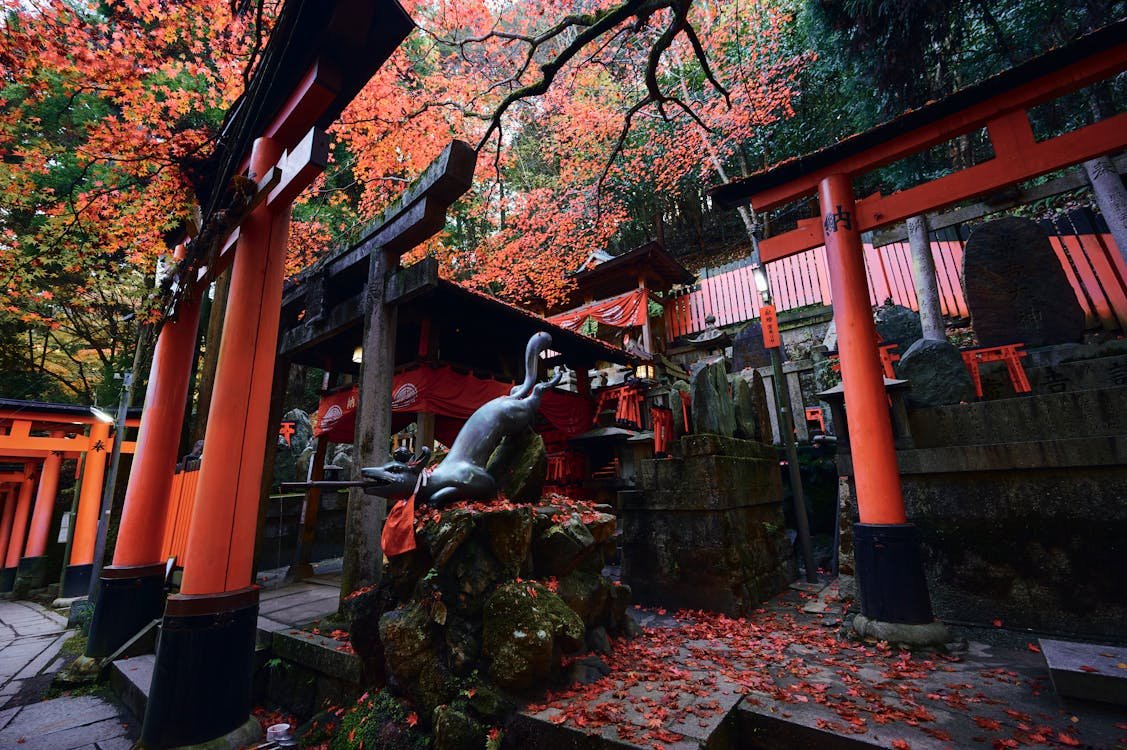
Image: Brilliant red maple
December Festivals: Year-End Traditions and Winter Illuminations
December brings the year to a close with festivals that combine traditional customs with modern celebrations.
Chichibu Night Festival: Fire and Floats
On December 2-3, the small city of Chichibu in Saitama Prefecture hosts one of Japan’s most spectacular winter festivals. This traditional Japanese festival features:
- Elaborate floats weighing up to 20 tons pulled through the streets
- A challenging uphill section requiring teams of pullers
- A two-hour fireworks display illuminating the night sky
- Food stalls serving regional specialties like Chichibu soba
The combination of illuminated floats, fireworks, and winter atmosphere makes this a highlight of December’s festival calendar.
Omisoka: New Year’s Eve Traditions
December 31st marks Omisoka, the last day of the year, observed with various customs throughout Japan:
- Joya no Kane: The ringing of temple bells 108 times at midnight
- Toshikoshi soba: Eating buckwheat noodles for longevity
- Hatsumode preparations: Getting ready for the first shrine visit of the New Year
While not a festival in the traditional sense, the nationwide customs of Omisoka create a special atmosphere as the year comes to a close.
Practical Tips for Festival Travelers in Japan
Planning Your Festival Itinerary
Aligning Your Travel Dates with Festival Calendars
When planning a trip focused on festivals in Japan by month, consider these strategic approaches:
- Golden Week (late April to early May): Offers multiple festivals but comes with crowds and higher prices
- Obon period (mid-August): Features numerous festivals nationwide but coincides with domestic travel peak
- Shoulder seasons (late May/June or September/October): Provide a balance of festival opportunities with fewer crowds
Remember that festival dates based on the lunar calendar may vary from year to year, so always verify current dates before finalizing plans.
Regional Festival Clusters for Efficient Travel
To maximize your festival experiences while minimizing travel time:
- Kansai Region (July): Combine Kyoto’s Gion Matsuri with Osaka’s Tenjin Matsuri
- Tohoku Region (August): Experience multiple summer festivals including Nebuta, Kanto, and Tanabata within a relatively compact area
- Greater Tokyo (May): Witness Kanda Matsuri and Sanja Matsuri in the same trip during odd-numbered years

Image: Screenshot of the GoHub eSIM webpage, highlighting the destination input field with “Japan” selected, illustrating how users can easily search for eSIM data plans.
💡Connectivity Tip: Use Gohub’s international eSIM to access real-time festival updates, transportation schedules, and weather forecasts while traveling between events. Having reliable internet access is invaluable when navigating Japan’s festival scene.
Festival Etiquette and Participation Tips
Respectful Observation and Participation
When attending traditional Japanese festivals, keep these etiquette points in mind:
- Observe ceremonial portions quietly and respectfully
- Follow crowd control instructions from festival staff
- Ask permission before photographing individual participants up close
- Look for designated visitor participation opportunities rather
Prefer deep cultural immersion? Pair your Japan adventure with a local homestay experience in Peru








